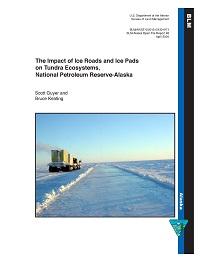Impacts of Ice Roads and Ice Pads on Tundra Ecosystems, National Petroleum Reserve-Alaska

Since the early 1970s, oil companies have been using ice roads to support exploratory drilling in the National Petroleum Reserve-Alaska (NPR-A). Ice roads are constructed by harvesting available ice and snow from lakes to form a road base and using tankers to spray water on the base to build up an ice surface. The use of ice roads by the petroleum industry alleviates the environmental impacts and high costs of gravel roads.
In 1978, a 37.5-mile ice road was built from the Kikiakrorak River to the Inigok drill site. This Kik-Inigok road required 35 million gallons of water for construction and maintenance and was utilized for trucking 132,000 tons of gravel to the Inigok drill site from the Kikiakrorak gravel pit. The ice road averaged 30 feet in width, and varied from 6 to 14 inches in thickness.
Studies were conducted by the Bureau of Land Management during the summer of 2001 and 2002 on ground disturbance caused by the construction of ice roads in NPR-A. Color infrared (CIR) photography taken in 1979 and 2002 was used to identify and locate ice road traces. The impacts of two single-season ice roads constructed in 2001 and one single-season ice road constructed in 2002 were compared to the single-season 1978 Kik-Inigok ice road. Random sample transects were located across each ice road trace, and each transect included impacted and non-impacted areas. Data was gathered from each transect on the profiles of the surface terrain, depth to permafrost, vegetation composition and vegetation damage. Equipment used to gather data included a Trimble ProXR GPS receiver and a Laser Alignment LB-9 (laser leveler). Surface elevation and depth to permafrost were recorded every two meters across each transect.
Results of permafrost profiles showed no significant difference in the depth to permafrost between the 1978 and the 2001 and 2002 ice roads. The 2001 and 2002 ice roads did, however, show damage to vegetation, with impacts to shrubs, forbs, and tussocks. These impacts were more significant on higher, drier sites; little to no evidence of damage was observed in wetlands. Transects across the 1978 Kik-Inigok ice road showed no evidence of damage to shrubs, forbs, or tussocks, all of which were vigorous and in good condition.
This data supports the conclusion that a single-season ice road can completely recover and return to its natural state in at least a 24-year period. Because of the greater impacts associated with tussock tundra uplands, future ice roads planning should concentrate on locating roads in wetland areas.
